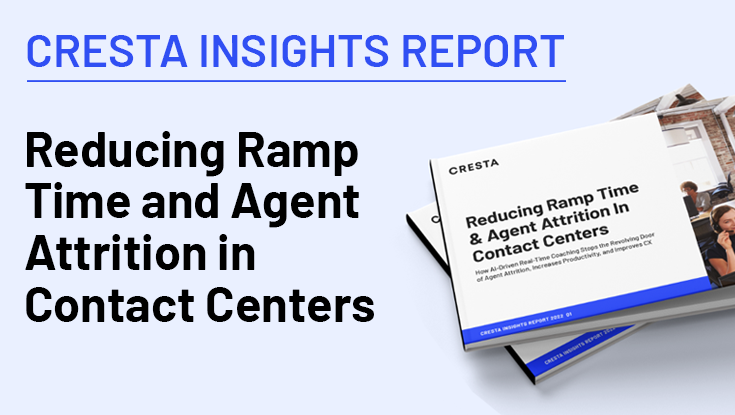
Customer service is a demanding profession. That’s not exactly a revelation — contact center attrition has jumped as high as 80% since the pandemic, and nearly 70% of customer service pros have considered leaving the industry entirely in recent months.
As customer service agents grapple with high volume and increased pressure, it’s harder than ever to perform well. Agents who are good at their jobs are happier (and vice versa) — happy agents are less likely to leave. But long ramp times and short tenure mean many agents only achieve proficiency right before churning.
There’s a simple (albeit elusive) solution to this negative feedback loop: invest in agents’ happiness.
Given what we know about the immense value of happy agents, what can be done to make them feel valued? In honor of customer service week, how can contact center leaders ensure that the people tasked with keeping customers happy are happy themselves?
By working to understand the distinct phases of the Agent Lifecycle, businesses can (and should) uncover steps to make customer service agents happy faster — and keep them happy long term.
Understanding the Agent Lifecycle
Through an analysis of 6,000 agents and 3.8 million conversations, we identified the Agent Lifecycle: a framework that enables targeted improvement by breaking agent experience into three distinct phases.
The first phase is Agent Ramp: the period from when agents are hired to when they reach proficiency. The next phase is Agent Performance, a time in which veteran agents hone their skills to become top performers. Lastly, Agent Progression is the phase where top performers advance to managerial roles.
Each of these phases presents unique opportunities to keep agents happy and satisfied — and unique risks that can lead to churn.
Keeping Agents Happy, One Phase at a Time
Because the Agent Lifecycle phases are proverbial worlds unto themselves as far as experience goes, it’s important to examine each phase individually as part of a holistic effort to boost happiness.
Agent Ramp
During this initial phase, agents’ happiness is largely determined by a sense of fit. Part of that feeling relates to culture, but another large chunk is related to skills. Agents want to feel they have the support and training necessary to excel in their new roles so they can reach proficiency faster and hit target KPIs.
So, what can managers do to make agents happy as they ramp up? Help them achieve early wins.
We know intuitively that doing well feels good, and that sentiment is echoed in data — agents who are satisfied with their roles are 8.5x less likely to leave and 3.3x more likely to feel empowered to solve customer issues.
There’s no magic spell for speeding agent ramp, but there are a few proven practices that help customer service agents achieve proficiency faster:
- Personalized, in-the-moment AI coaching to give agents greater confidence
- Provide interactive onboarding and set your agents up with a new colleague every day so they don’t feel alone
- Week over week coaching plan with realistic and attainable goals to set agents up for success
- Live conversation monitoring to ensure that if extra support is needed, managers know
By giving customer service agents access to the tools, knowledge, and coaching they need to succeed early on, contact center leaders cultivate an environment where it’s easier to win, so it’s easier to be happy.
Agent Performance
Once they’ve achieved proficiency and are more comfortable in their roles, customer service agents can shift their focus from being good at their jobs to being the best at their jobs.
Continuous upskilling is a key happiness driver in this phase. If they are always honing their skills, agents can hit target KPIs consistently. In contact centers that incentivize consistently high performance, this can mean better compensation or more preferable shifts.
Of course, there are performance gaps in every contact center — if agents start to feel their skills aren’t progressing as they should be, they’re more likely to leave.
So, supporting improvement long after onboarding is vital for agent happiness; some of the features that can help include:
- Gamification elements to drive healthy competition and help agents see how they rank
- Efficiency tools like automatic note taking and summarization so that agents can concentrate on the customer
- Real-time coaching to reinforce successful behaviors more effectively
More often than not, even veteran agents have room to improve. Giving them the right tools can drive motivation, help them upskill, and ensure they feel the continued support of their managers — all of this fosters confidence, pride, and overall happiness.
Agent Progression
Customer service agents who have grown increasingly skilled and reached top performer status consistently need something new to feel happy in their roles: advancement opportunities. And not just opportunities, but also a clear path to attaining them.
Agents who feel that their careers have grown stagnant or that their performance isn’t being recognized and rewarded are a higher churn risk.
To ensure top performers feel they’re on track for growth, contact center leaders must do two things:
- Establish and communicate performance milestones that will translate to rewards or opportunities (for example, if an agent maintains target KPIs for a certain period of time, they automatically receive higher compensation, an elevated title, or the opportunity to apply for managerial roles).
- Give agents the sense that these milestones are attainable by providing the necessary tools and support, then give them visibility into their progress.
Although agents’ paths to advancement and the milestones along the way will vary by organization, contact center leaders can show proactive interest in keeping and advancing their best agents with features like:
-
- Customized coaching plans that target milestone-specific KPIs
- Performance dashboards to give managers visibility into top performers and to give agents visibility into their progress
- Automatic summarization, note taking, and suggestions to cut out ACW and improve efficiency during conversations, bringing KPI targets and milestones within reach
Great customer service agents are in high demand — keep your top performers happy by recognizing their hard work and rewarding it with growth opportunities.
The Value of Happy Agents
We’ve already established that happy agents perform better and stay in their roles longer; that translates to big benefits for business. By targeting key happiness contributors at every phase, Cresta has helped clients:
- Cut ramp time by 67%
- Increase Employee Satisfaction by over 30%
- Reduce AHT among new agents by 37%
- Improve average agent attrition by 50%
KPIs like these create savings and drive customer loyalty. But the value of happy agents goes beyond what’s easily quantifiable. Customers who interact with happy agents are more likely to have a happy experience thanks to a psychological phenomenon called emotional contagion.
Simply put, emotions are catching. As customer expectations reach an all-time high, businesses are in search of new ways to build loyalty. But as it turns out, the most impactful method may simply be to make customer service agents happier — it’s infectious.
Throughout the next few days (and the other 51 weeks of the year), take steps to prioritize your customer service agents’ happiness, and watch that happiness build results.
Get in touch to learn more about how Cresta can help improve the agent experience at every phase.


